Significant Reversal of Facial Wrinkle, Pigmented Spot and Roughness by Daily Application of Galactomyces Ferment Filtrate-Containing Skin Products for 12 Months—An 11-Year Longitudinal Skin Aging Rejuvenation Study
Abstract
:1. Introduction
2. Materials and Methods
2.1. Subjects and Study Protocol
2.2. Facial Optical Imaging and Objective Image Analysis
2.3. Biophysical Measurements
2.4. Statistical Analysis
3. Results
3.1. Aggravation of Skin Aging Parameters from 1999 to 2010
3.2. Application of G3 Products Reversed Facial Skin Aging
3.3. Change of Skin Hydration Was Negatively Correlated with Change of Skin Aging Parameters
3.4. Effects of G3 Product Application on Other Skin Parameters
4. Discussion
Supplementary Materials
Author Contributions
Funding
Institutional Review Board Statement
Informed Consent Statement
Data Availability Statement
Acknowledgments
Conflicts of Interest
References
- Miyamoto, K.; Inoue, Y.; Hsueh, K.; Liang, Z.; Yan, X.; Yoshii, T.; Furue, M. Characterization of comprehensive appearances of skin ageing: An 11-year longitudinal study on facial skin ageing in Japanese females at Akita. J. Dermatol. Sci. 2011, 64, 229–236. [Google Scholar] [CrossRef] [PubMed]
- Zhang, Y.; Liu, X.; Wang, J.; Du, L.; Ma, Y.; Liu, W.; Ye, R.; Yang, Y.; Xu, H. Analysis of Multi-Part Phenotypic Changes in Skin to Characterize the Trajectory of Skin Aging in Chinese Women. Clin. Cosmet. Investig. Dermatol. 2022, 15, 631–642. [Google Scholar] [CrossRef] [PubMed]
- Zargaran, D.; Zoller, F.; Zargaran, A.; Weyrich, T.; Mosahebi, A. Facial skin ageing: Key concepts and overview of processes. Int. J. Cosmet. Sci. 2022, 44, 414–420. [Google Scholar] [CrossRef] [PubMed]
- Flament, F.; Jacquet, L.; Ye, C.; Amar, D.; Kerob, D.; Jiang, R.; Zhang, Y.; Kroely, C.; Delaunay, C.; Passeron, T. Artificial intelligence analysis of over half a million European and Chinese women reveals striking differences in the facial skin ageing process. J. Eur. Acad. Dermatol. Venereol. 2022, 36, 1136–1142. [Google Scholar] [CrossRef] [PubMed]
- Takei, K.; Mitoma, C.; Hashimoto-Hachiya, A.; Takahara, M.; Tsuji, G.; Nakahara, T.; Furue, M. Galactomyces fermentation filtrate prevents T helper 2-mediated reduction of filaggrin in an aryl hydrocarbon receptor-dependent manner. Clin. Exp. Dermatol. 2015, 40, 786–793. [Google Scholar] [CrossRef]
- Hashimoto-Hachiya, A.; Tsuji, G.; Furue, M. Antioxidants cinnamaldehyde and Galactomyces fermentation filtrate downregulate senescence marker CDKN2A/p16INK4A via NRF2 activation in keratinocytes. J. Dermatol. Sci. 2019, 96, 53–56. [Google Scholar] [CrossRef]
- Pang, J.-H.; Wong, W.-R.; Hakozaki, T.; Yoshii, T.; Chen, T.-Y. Up-regulation of tight junction-related proteins and increase of human epidermal keratinocytes barrier function by Saccharomycosis ferment filtrate. J. Cosmet. Dermatol. Sci. Appl. 2011, 1, 15–24. [Google Scholar] [CrossRef]
- Kataoka, S.; Hattori, K.; Date, A.; Tamura, H. Human keratinocyte caspase-14 expression is altered in human epidermal 3D models by dexamethasone and by natural products used in cosmetics. Arch. Dermatol. Res. 2013, 305, 683–689. [Google Scholar] [CrossRef]
- Yan, X.; Tsuji, G.; Hashimoto-Hachiya, A.; Furue, M. Galactomyces Ferment Filtrate Potentiates an Anti-Inflammaging System in Keratinocytes. J. Clin. Med. 2022, 11, 6338. [Google Scholar] [CrossRef]
- Miyamoto, K.; Dissanayake, B.; Omotezako, T.; Takemura, M.; Tsuji, G.; Furue, M. Daily fluctuation of facial pore area, roughness and redness among young Japanese women; Beneficial effects of Galactomyces ferment filtrate containing antioxidative skin care formula. J. Clin. Med. 2021, 10, 2502. [Google Scholar] [CrossRef]
- Miyamoto, K.; Munakata, Y.; Yan, X.; Tsuji, G.; Furue, M. Enhanced Fluctuations in Facial Pore Size, Redness, and TEWL Caused by Mask Usage Are Normalized by the Application of a Moisturizer. J. Clin. Med. 2022, 11, 2121. [Google Scholar] [CrossRef] [PubMed]
- Lee, Y.I.; Choi, S.; Roh, W.S.; Lee, J.H.; Kim, T.-G. Cellular Senescence and Inflammaging in the Skin Microenvironment. Int. J. Mol. Sci. 2021, 22, 3849. [Google Scholar] [CrossRef] [PubMed]
- Pilkington, S.M.; Bulfone-Paus, S.; Griffiths, C.E.; Watson, R.E. Inflammaging and the Skin. J. Investig. Dermatol. 2020, 141, 1087–1095. [Google Scholar] [CrossRef] [PubMed]
- Takei, K.; Hashimoto-Hachiya, A.; Takahara, M.; Tsuji, G.; Nakahara, T.; Furue, M. Cynaropicrin attenuates UVB-induced oxidative stress via the AhR-Nrf2-Nqo1 pathway. Toxicol. Lett. 2015, 234, 74–80. [Google Scholar] [CrossRef]
- Tsuji, G.; Takahara, M.; Uchi, H.; Takeuchi, S.; Mitoma, C.; Moroi, Y.; Furue, M. An environmental contaminant, benzo(a)pyrene, induces oxidative stress-mediated interleukin-8 production in human keratinocytes via the aryl hydrocarbon receptor signaling pathway. J. Dermatol. Sci. 2011, 62, 42–49. [Google Scholar] [CrossRef]
- Furue, K.; Ito, T.; Tanaka, Y.; Yumine, A.; Hashimoto-Hachiya, A.; Takemura, M.; Murata, M.; Yamamura, K.; Tsuji, G.; Furue, M. Cyto/chemokine profile of in vitro scratched keratinocyte model: Implications of significant upregulation of CCL20, CXCL8 and IL36G in Koebner phenomenon. J. Dermatol. Sci. 2019, 94, 244–251. [Google Scholar] [CrossRef]
- Furue, K.; Ito, T.; Tanaka, Y.; Hashimoto-Hachiya, A.; Takemura, M.; Murata, M.; Kido-Nakahara, M.; Tsuji, G.; Nakahara, T.; Furue, M. The EGFR-ERK/JNK-CCL20 Pathway in Scratched Keratinocytes May Underpin Koebnerization in Psoriasis Patients. Int. J. Mol. Sci. 2020, 21, 434. [Google Scholar] [CrossRef]
- Furue, K.; Ito, T.; Tsuji, G.; Nakahara, T.; Furue, M. Scratch wound-induced CXCL8 upregulation is EGFR-dependent in keratinocytes. J. Dermatol. Sci. 2020, 99, 209–212. [Google Scholar] [CrossRef]
- Pena, A.M.; Baldeweck, T.; Decencière, E.; Koudoro, S.; Victorin, S.; Raynaud, E.; Ngo, B.; Bastien, P.; Brizion, S.; Tancrède-Bohin, E. In vivo multiphoton multiparametric 3D quantification of human skin aging on forearm and face. Sci. Rep. 2022, 12, 14863. [Google Scholar] [CrossRef]
- Campiche, R.; Trevisan, S.; Séroul, P.; Rawlings, A.V.; Adnet, C.; Imfeld, D.; Voegeli, R. Appearance of aging signs in differently pigmented facial skin by a novel imaging system. J. Cosmet. Dermatol. 2018, 18, 614–627. [Google Scholar] [CrossRef]
- Cho, C.; Lee, E.; Park, G.; Cho, E.; Kim, N.; Shin, J.; Woo, S.; Ha, J.; Hwang, J. Evaluation of facial skin age based on biophysical properties in vivo. J. Cosmet. Dermatol. 2021, 21, 3546–3554. [Google Scholar] [CrossRef] [PubMed]
- Tsuji, G.; Hashimoto-Hachiya, A.; Matsuda-Taniguchi, T.; Takai-Yumine, A.; Takemura, M.; Yan, X.; Furue, M.; Nakahara, T. Natural Compounds Tapinarof and Galactomyces Ferment Filtrate Downregulate IL-33 Expression via the AHR/IL-37 Axis in Human Keratinocytes. Front. Immunol. 2022, 13, 745997. [Google Scholar] [CrossRef] [PubMed]
- Kimball, A.B.; Alora-Palli, M.B.; Tamura, M.; Mullins, L.A.; Soh, C.; Binder, R.L.; Houston, N.A.; Conley, E.D.; Tung, J.Y.; Annunziata, N.E.; et al. Age-induced and photoinduced changes in gene expression profiles in facial skin of Caucasian females across 6 decades of age. J. Am. Acad. Dermatol. 2018, 78, 29–39. [Google Scholar] [CrossRef] [PubMed]
- Hakozaki, T.; Minwalla, L.; Zhuang, J.; Chhoa, M.; Matsubara, A.; Miyamoto, K.; Greatens, A.; Hillebrand, G.; Bissett, D.; Boissy, R. The effect of niacinamide on reducing cutaneous pigmentation and suppression of melanosome transfer. Br. J. Dermatol. 2002, 147, 20–31. [Google Scholar] [CrossRef] [PubMed]
- Mukherjee, S.; Date, A.; Patravale, V.; Korting, H.C.; Roeder, A.; Weindl, G. Retinoids in the treatment of skin aging: An overview of clinical efficacy and safety. Clin. Interv. Aging 2006, 1, 327–348. [Google Scholar] [CrossRef]

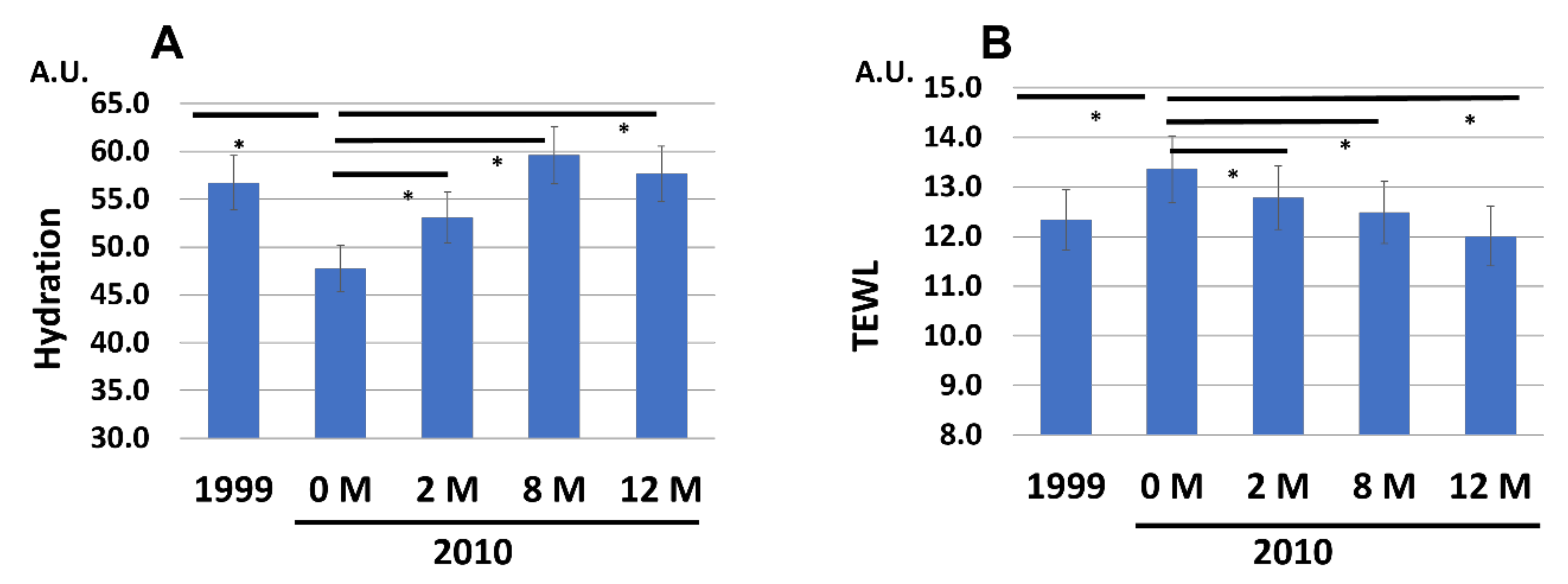
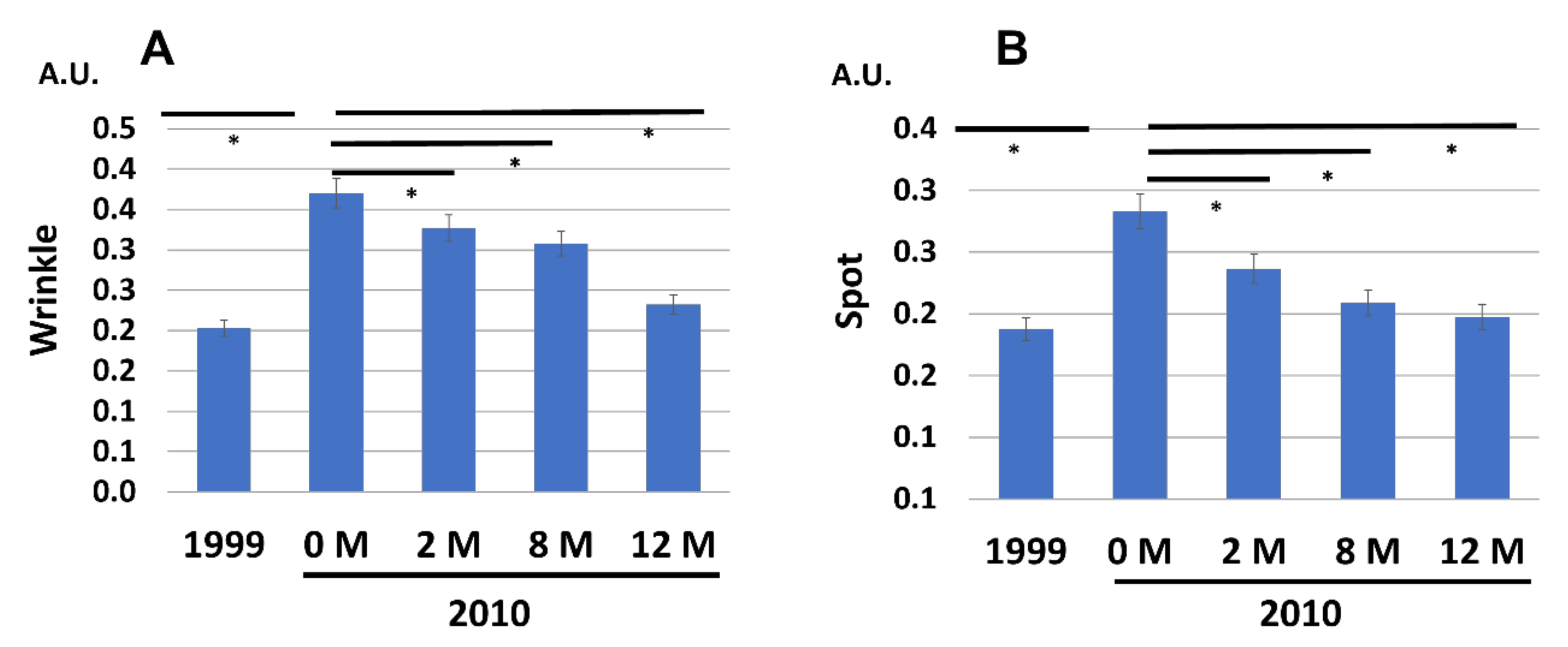
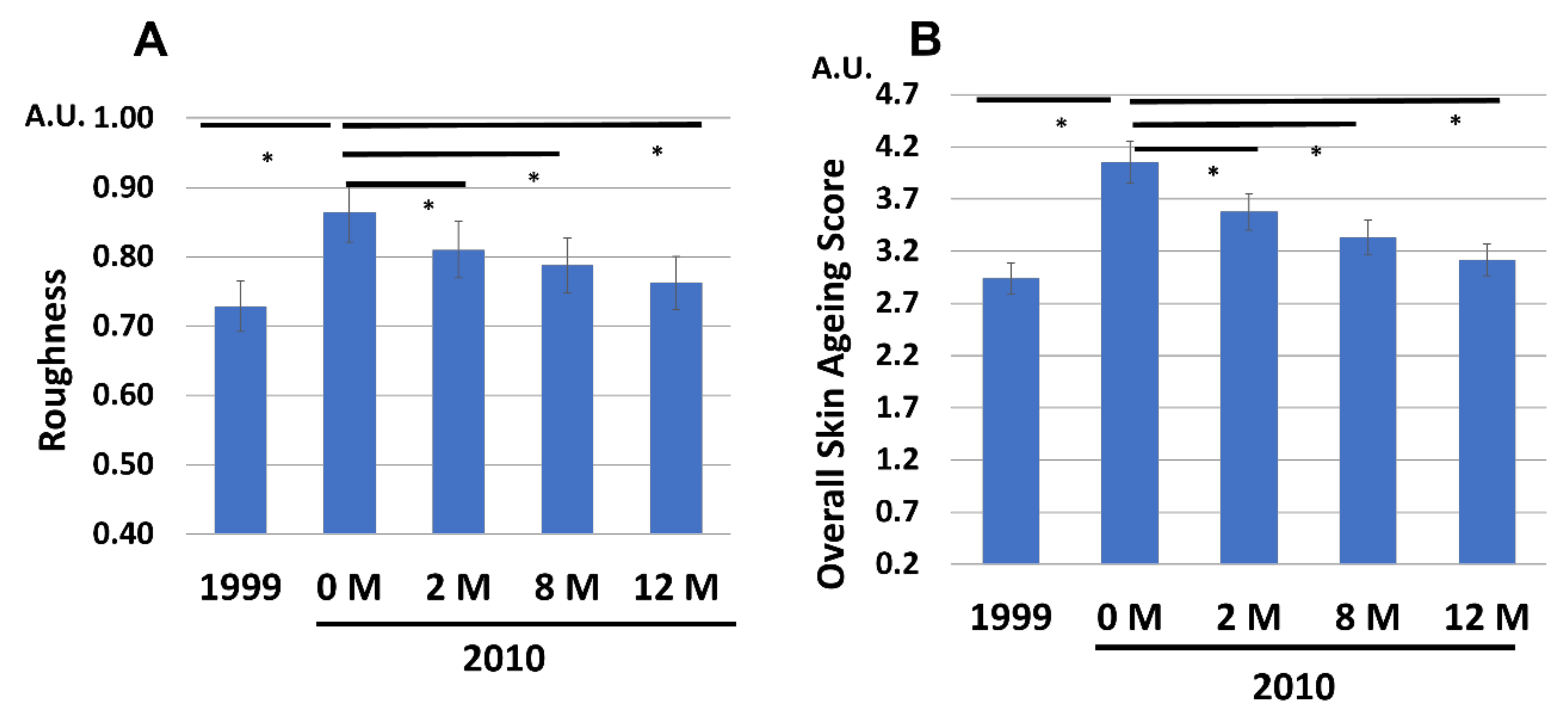
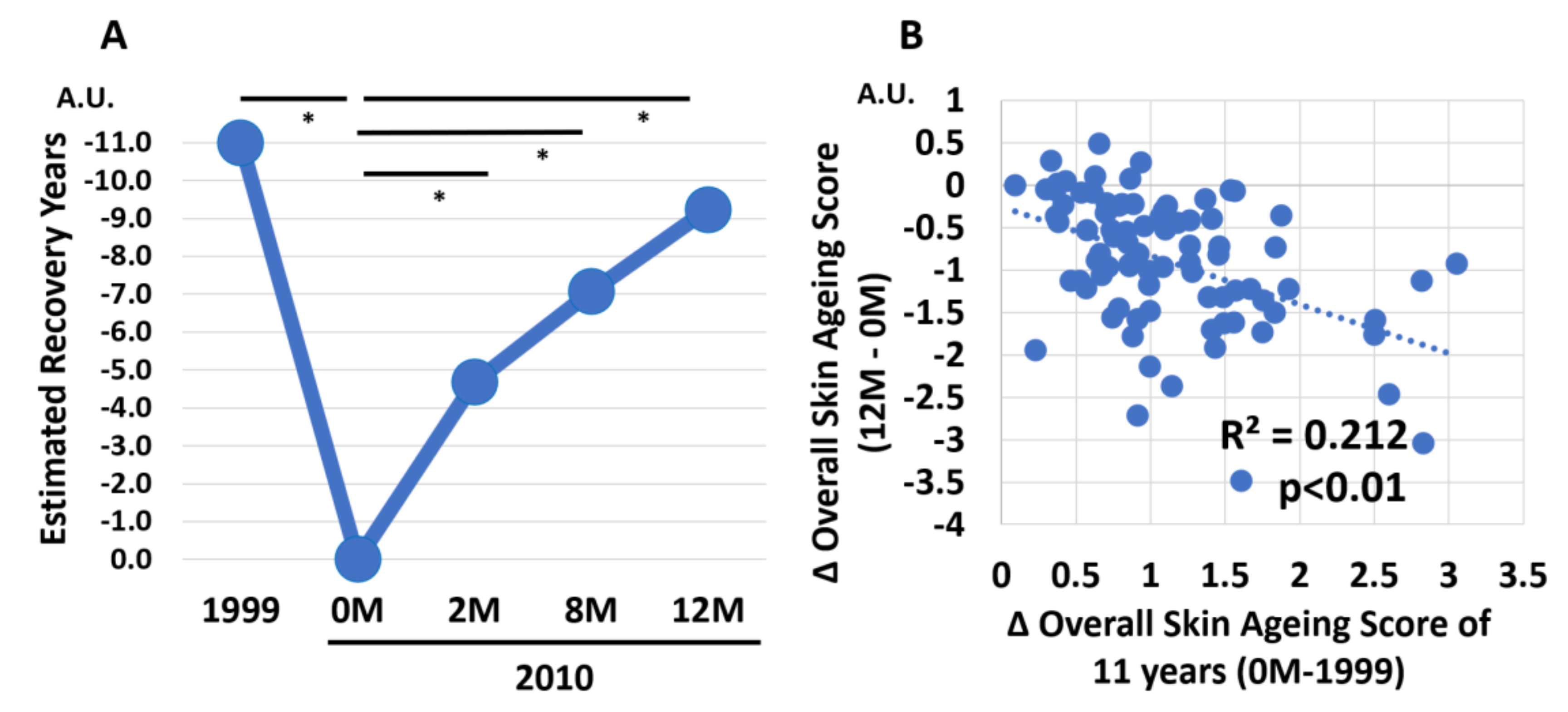
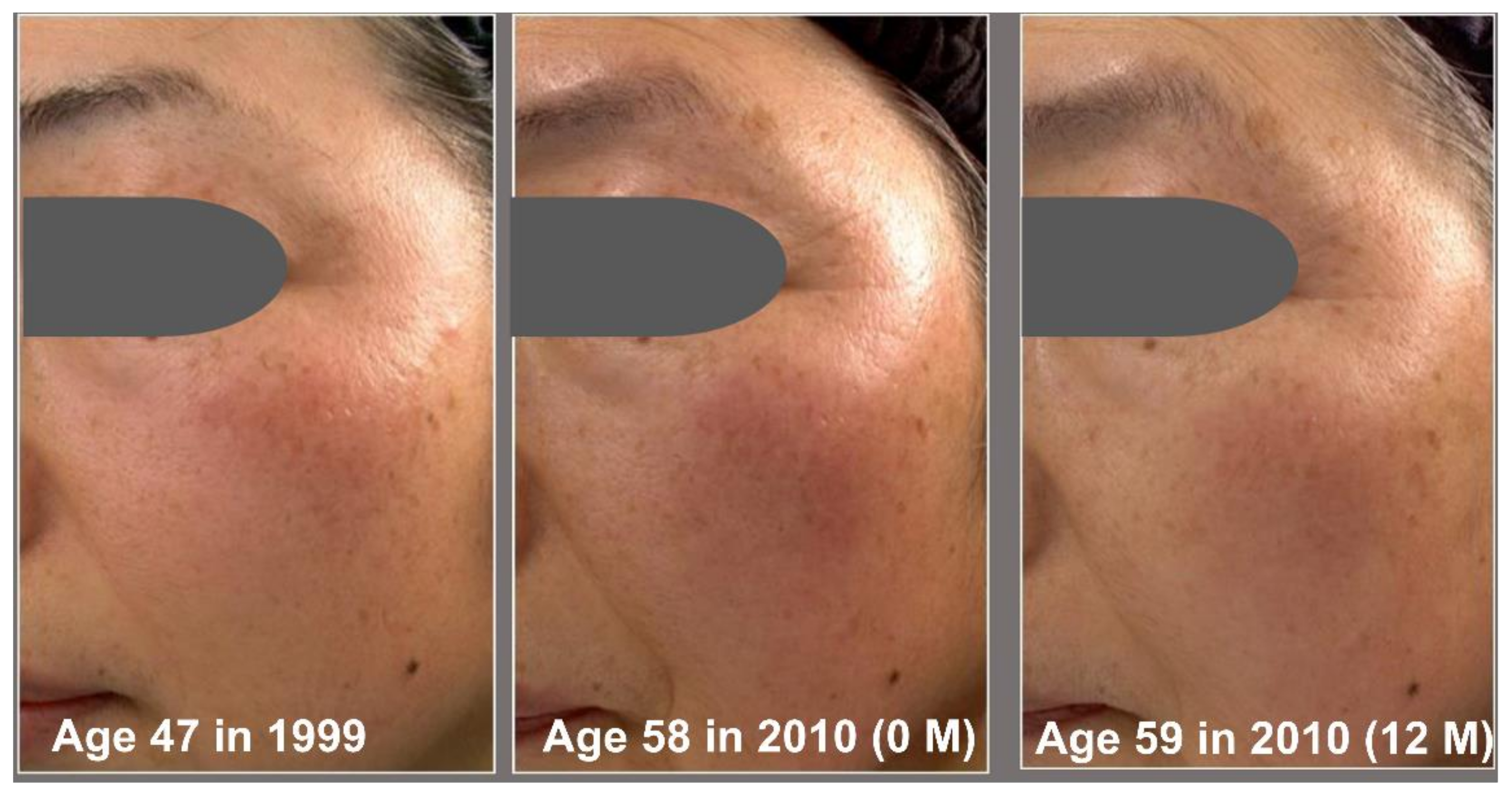
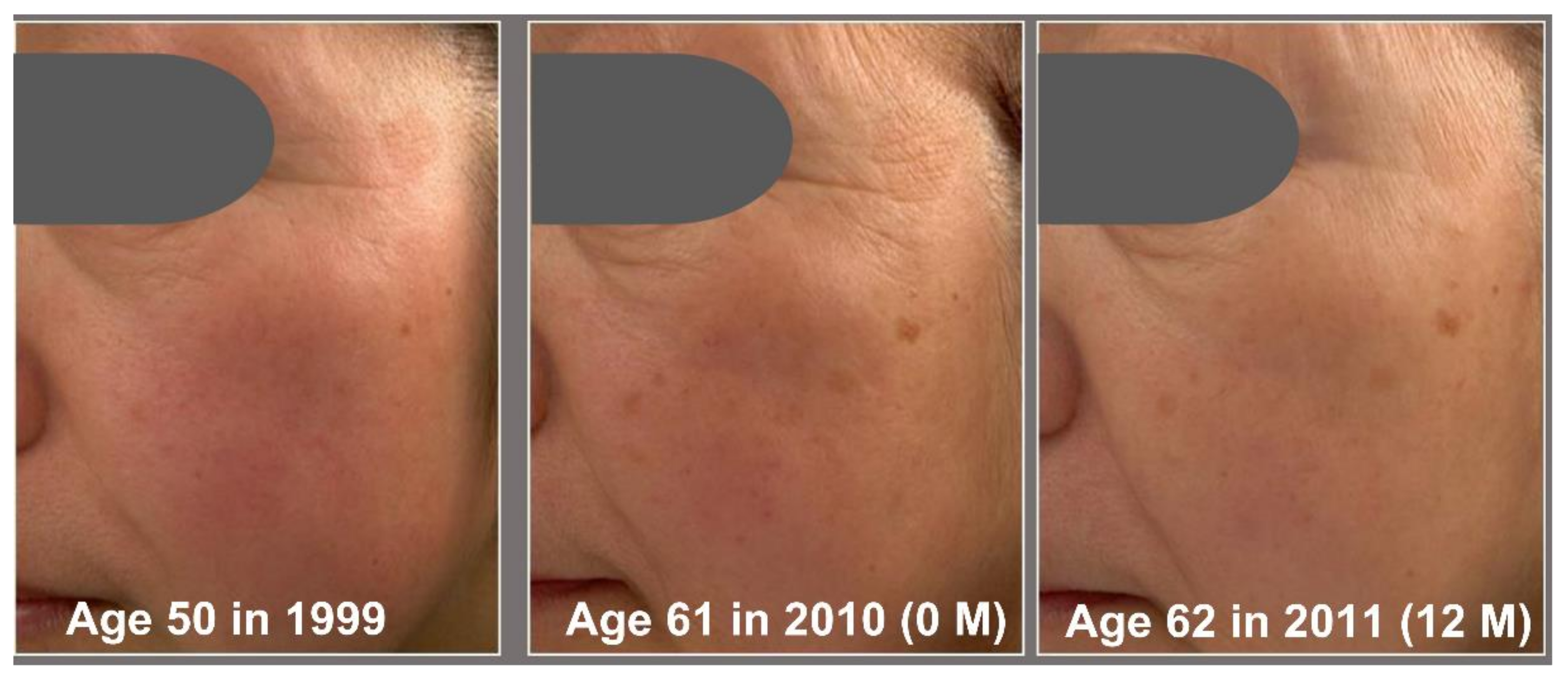
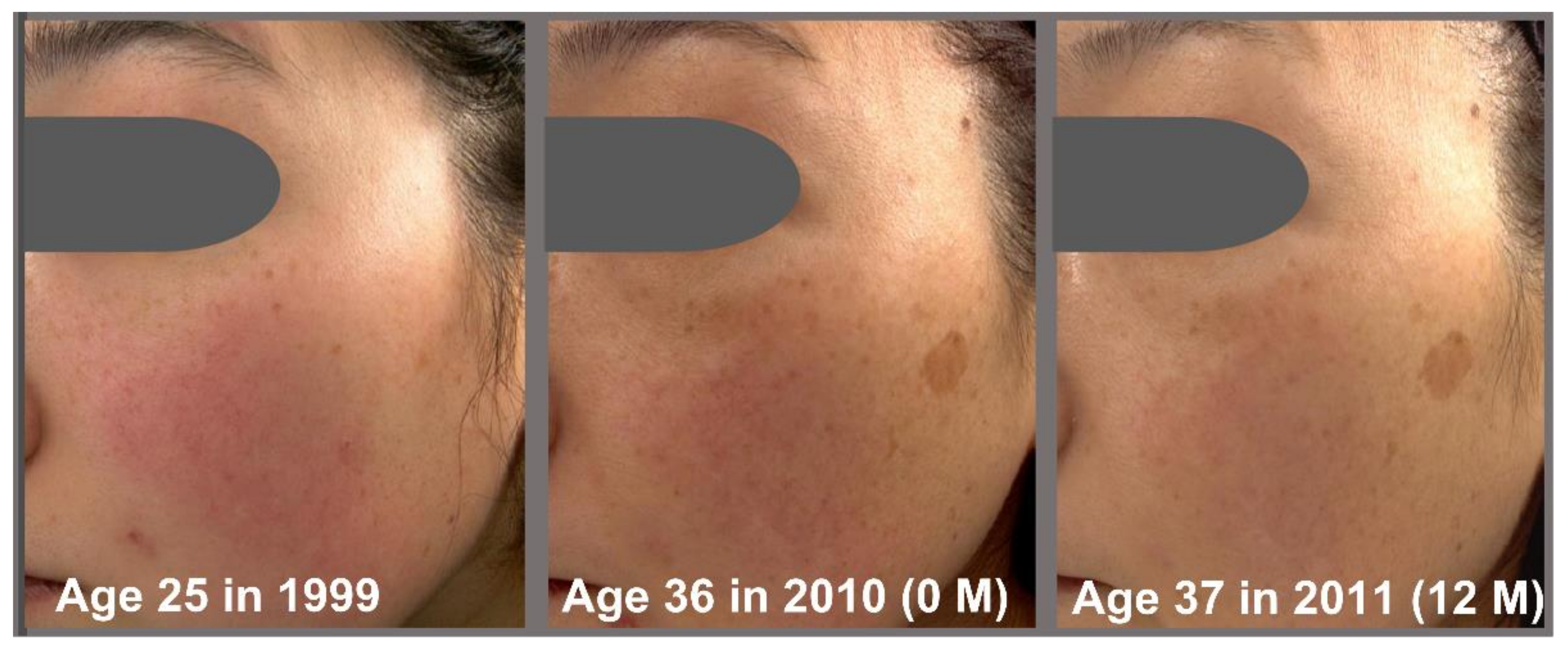
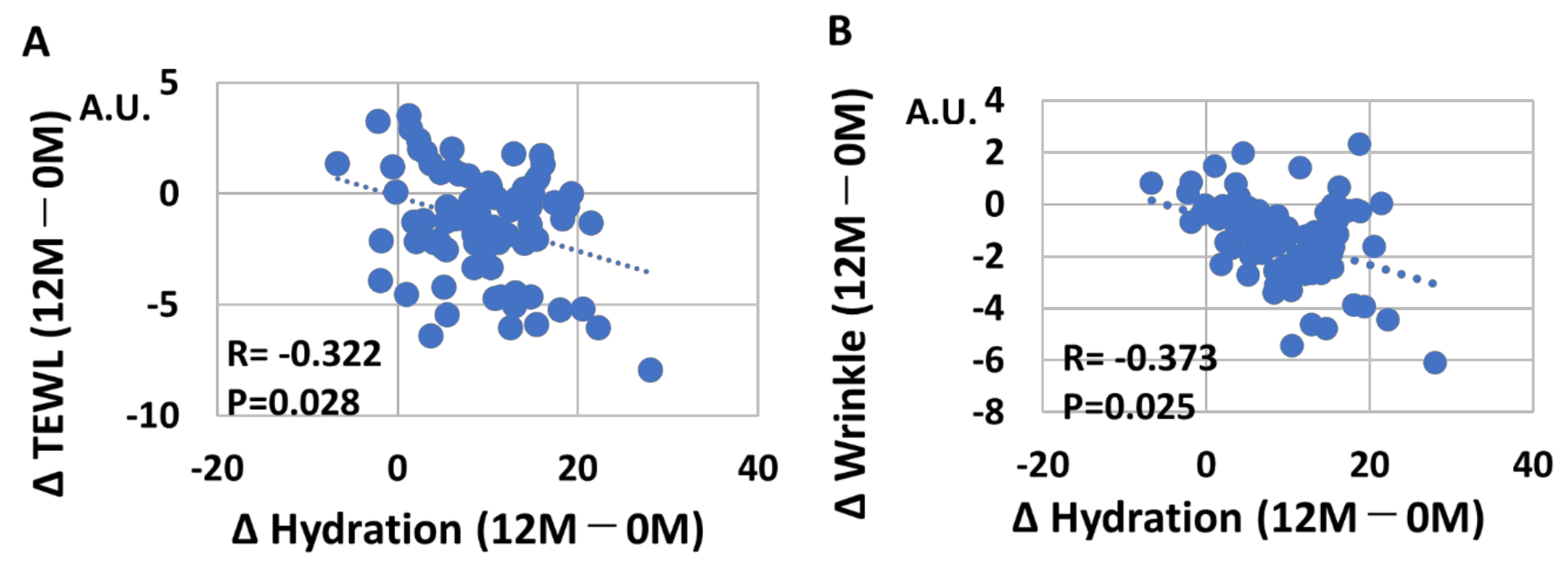

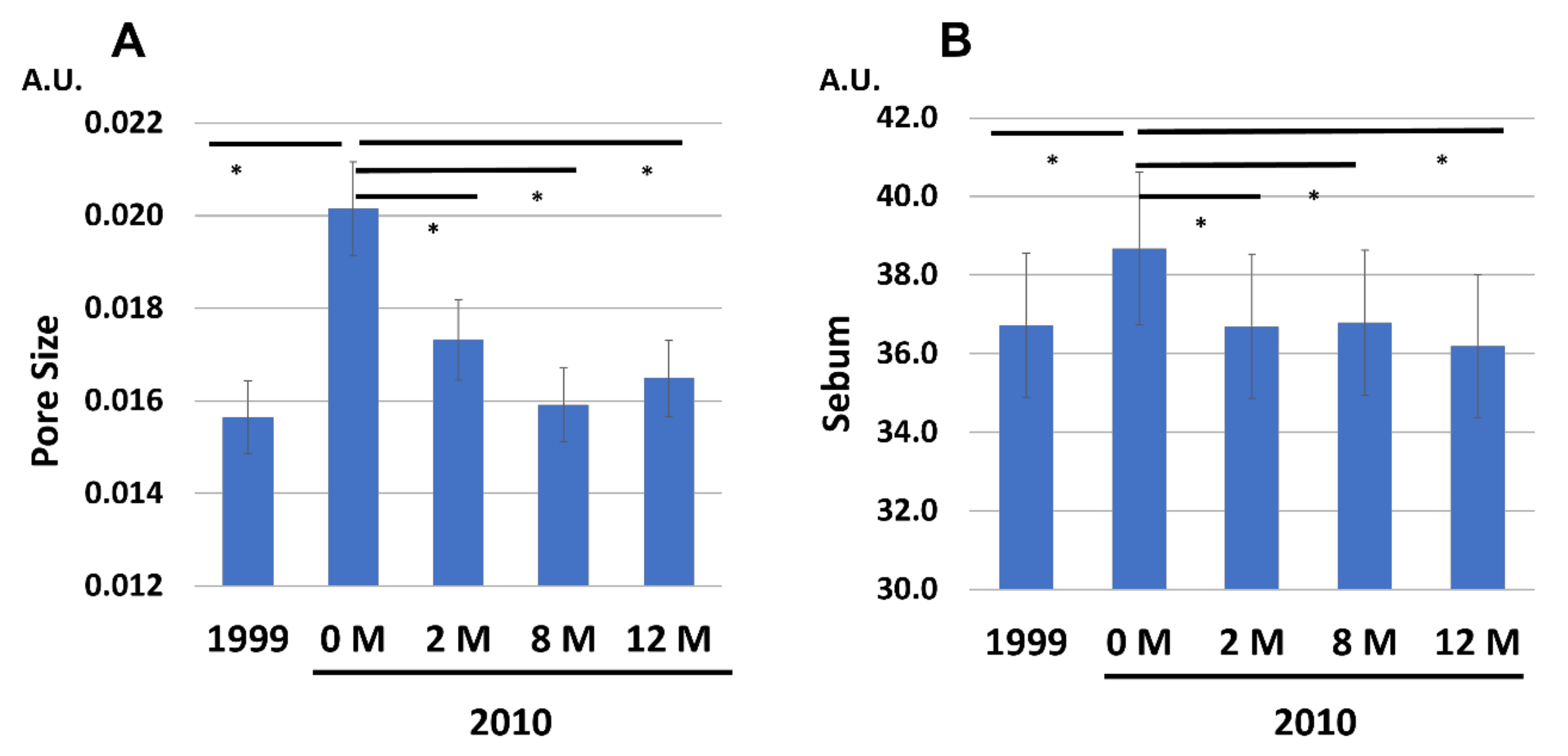

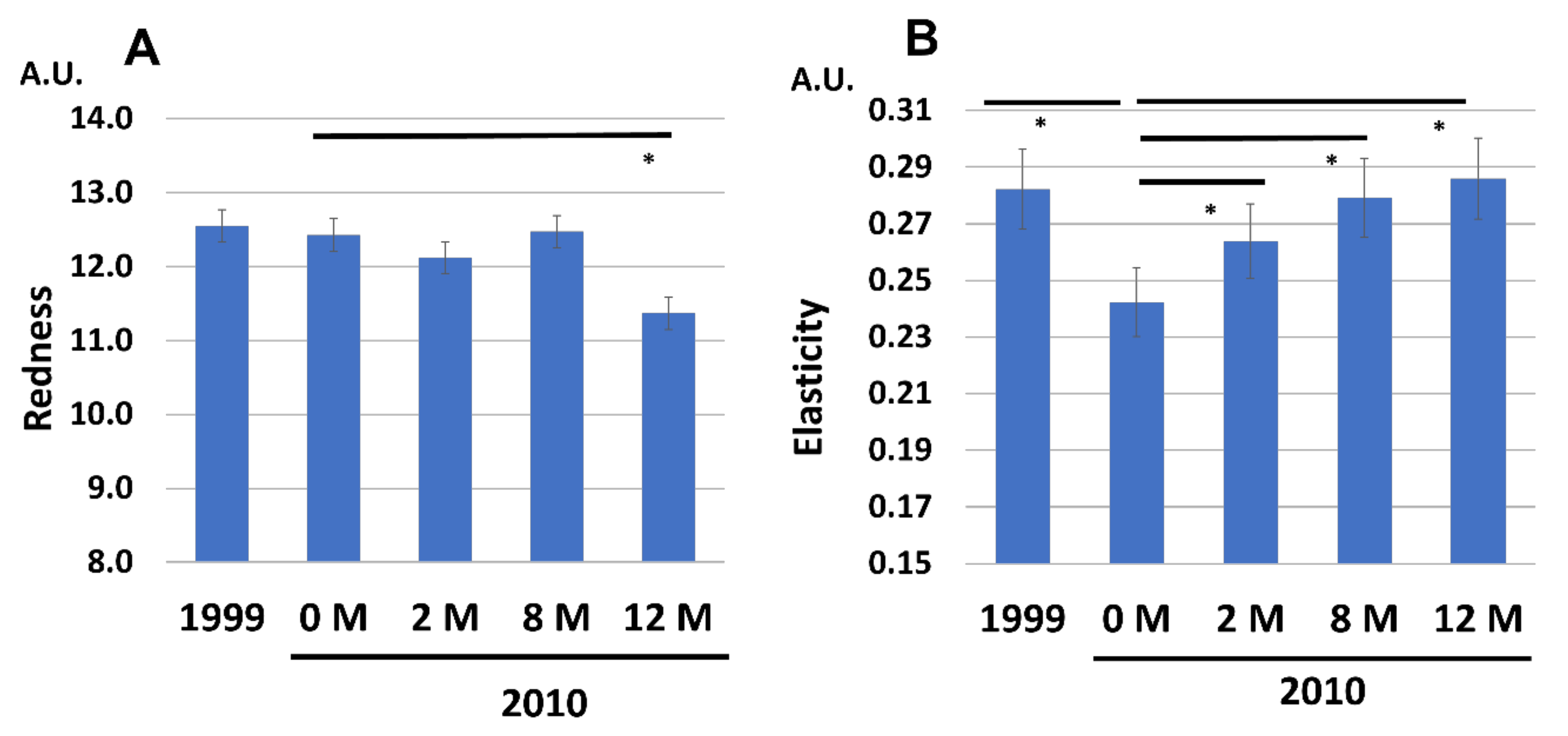
| 1999 | 2010 (0 M) | p-Value | |
|---|---|---|---|
| Hydration | 56.71 ± 7.11 | 47.76 ± 8.68 | <0.01 |
| TEWL | 12.34 ± 3.83 | 13.36 ± 3.18 | <0.01 |
| Wrinkles | 0.2 ± 0.18 | 0.37 ± 0.28 | <0.01 |
| Spots | 0.19 ± 0.11 | 0.28 ± 0.15 | <0.01 |
| Roughness | 0.73 ± 0.4 | 0.86 ± 0.42 | <0.01 |
| Lightness | 59.27 ± 2.69 | 57.6 ± 2.45 | <0.01 |
| Redness | 12.55 ± 1.92 | 12.43 ± 1.54 | 0.352 |
| Yellowness | 20.39 ± 1.93 | 21.63 ± 1.93 | 0.028 |
| Pore size | 0.0157 ± 0.0122 | 0.0202 ± 0.011 | <0.01 |
| Sebum | 36.73 ± 29.94 | 38.68 ± 34.11 | 0.033 |
| Elasticity | 0.28 ± 0.05 | 0.24 ± 0.06 | <0.01 |
Disclaimer/Publisher’s Note: The statements, opinions and data contained in all publications are solely those of the individual author(s) and contributor(s) and not of MDPI and/or the editor(s). MDPI and/or the editor(s) disclaim responsibility for any injury to people or property resulting from any ideas, methods, instructions or products referred to in the content. |
© 2023 by the authors. Licensee MDPI, Basel, Switzerland. This article is an open access article distributed under the terms and conditions of the Creative Commons Attribution (CC BY) license (https://creativecommons.org/licenses/by/4.0/).
Share and Cite
Miyamoto, K.; Inoue, Y.; Yan, X.; Yagi, S.; Suda, S.; Furue, M. Significant Reversal of Facial Wrinkle, Pigmented Spot and Roughness by Daily Application of Galactomyces Ferment Filtrate-Containing Skin Products for 12 Months—An 11-Year Longitudinal Skin Aging Rejuvenation Study. J. Clin. Med. 2023, 12, 1168. https://doi.org/10.3390/jcm12031168
Miyamoto K, Inoue Y, Yan X, Yagi S, Suda S, Furue M. Significant Reversal of Facial Wrinkle, Pigmented Spot and Roughness by Daily Application of Galactomyces Ferment Filtrate-Containing Skin Products for 12 Months—An 11-Year Longitudinal Skin Aging Rejuvenation Study. Journal of Clinical Medicine. 2023; 12(3):1168. https://doi.org/10.3390/jcm12031168
Chicago/Turabian StyleMiyamoto, Kukizo, Yasuko Inoue, Xianghong Yan, Shiomi Yagi, Sudarsana Suda, and Masutaka Furue. 2023. "Significant Reversal of Facial Wrinkle, Pigmented Spot and Roughness by Daily Application of Galactomyces Ferment Filtrate-Containing Skin Products for 12 Months—An 11-Year Longitudinal Skin Aging Rejuvenation Study" Journal of Clinical Medicine 12, no. 3: 1168. https://doi.org/10.3390/jcm12031168
APA StyleMiyamoto, K., Inoue, Y., Yan, X., Yagi, S., Suda, S., & Furue, M. (2023). Significant Reversal of Facial Wrinkle, Pigmented Spot and Roughness by Daily Application of Galactomyces Ferment Filtrate-Containing Skin Products for 12 Months—An 11-Year Longitudinal Skin Aging Rejuvenation Study. Journal of Clinical Medicine, 12(3), 1168. https://doi.org/10.3390/jcm12031168





